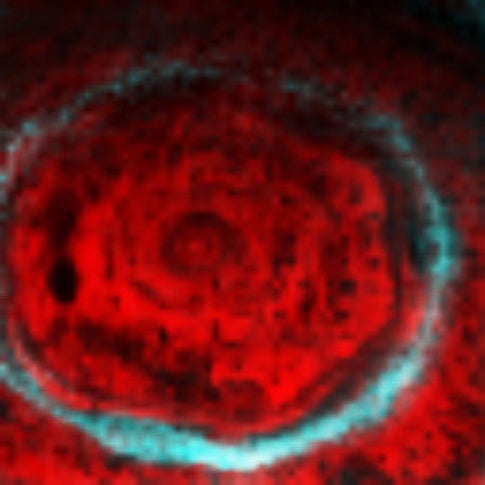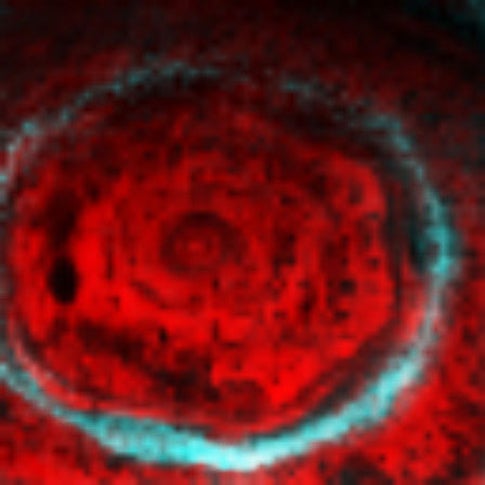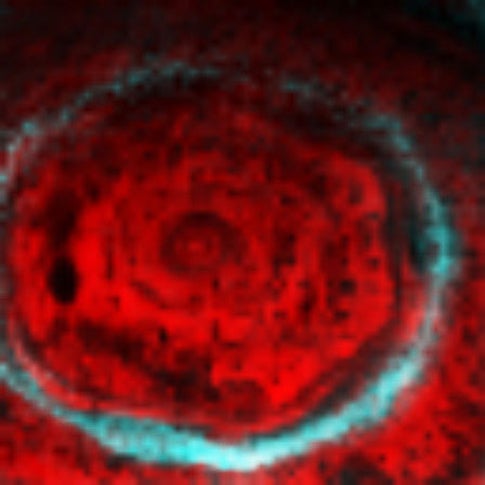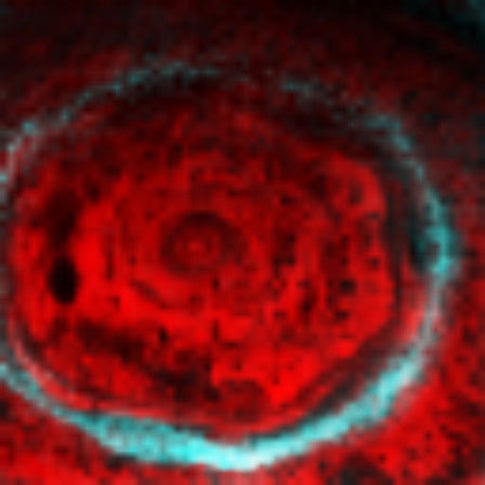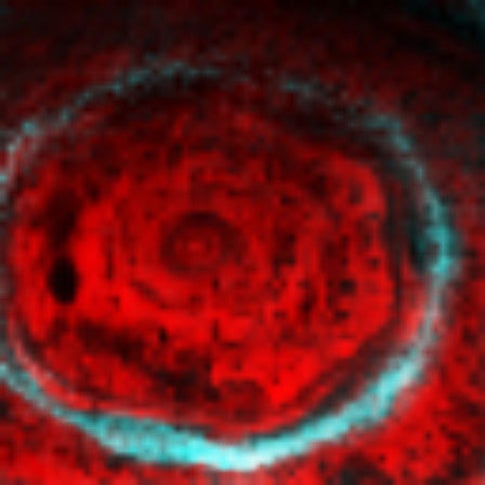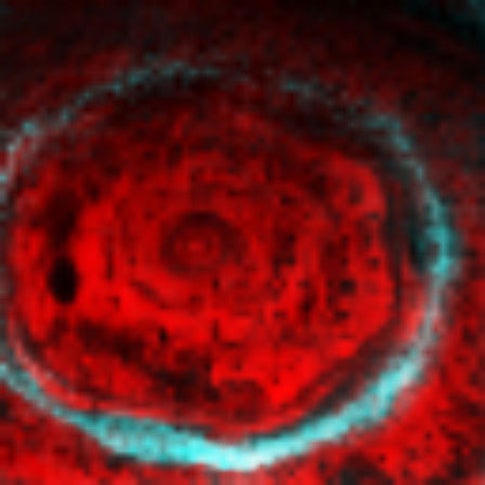Cassini’s Visual and Infrared Mapping Spectrometer captured this view of Saturn’s north pole. The most prominent features include a bright reddish hexagon, which represents a clearing in the clouds that allows us to see some 47 miles (75 km) below the bright clouds seen at visible wavelengths, and a bluish aurora created when charged particles trapped in Saturn’s magnetic field excite high-altitude molecules.
NASA/JPL/University of Arizona
Since it arrived at Saturn in mid-2004, the Cassini spacecraft has been studying the planet, its rings, and its entourage of more than 50 moons. It has discovered two new rings (the Janus/Epimetheus and the Pallene rings), lakes of liquid hydrocarbons on Titan, plumes of water ice erupting on Enceladus, plus a whole lot more. And its job is far from over. Later this year, Cassini will make its second close pass by Tethys, its second close pass by Rhea, and its initial close encounter with Iapetus. And that doesn’t count a dozen or so flybys of Titan. As we wait for these significant events, sit back and enjoy these recent highlights from Saturn.
Saturn’s north pole
Cassini’s Visual and Infrared Mapping Spectrometer captured this view of Saturn’s north pole. The most prominent features include a bright reddish hexagon, which represents a clearing in the clouds that allows us to see some 47 miles (75 km) below the bright clouds seen at visible wavelengths, and a bluish aurora created when charged particles trapped in Saturn’s magnetic field excite high-altitude molecules.
NASA/JPL/University of Arizona
Cassini’s Visual and Infrared Mapping Spectrometer captured this view of Saturn’s north pole. The most prominent features include a bright reddish hexagon, which represents a clearing in the clouds that allows us to see some 47 miles (75 km) below the bright clouds seen at visible wavelengths, and a bluish aurora created when charged particles trapped in Saturn’s magnetic field excite high-altitude molecules.
NASA/JPL/University of Arizona
Encke Division
Bright, kinked ringlets populate the narrow Encke Division, while the brilliant, outer F ring displays its signature knots.
NASA/JPL/SSI
Bright, kinked ringlets populate the narrow Encke Division, while the brilliant, outer F ring displays its signature knots.
NASA/JPL/SSI
Triple silhouette
A triple silhouette highlights this Cassini image. Saturn’s rings cut across the disk of Titan, which appears only because its globe-encircling haze scatters sunlight. Enceladus and its icy jets appear on the lower right of Titan’s crescent.
NASA/JPL/SSI
A triple silhouette highlights this Cassini image. Saturn’s rings cut across the disk of Titan, which appears only because its globe-encircling haze scatters sunlight. Enceladus and its icy jets appear on the lower right of Titan’s crescent.
NASA/JPL/SSI
Titan’s lake region
Titan’s lake region lies near the massive moon’s north pole. This radar image reveals several liquid-filled depressions, the largest of which (at far right) exceeds the dimensions of North America’s Lake Superior.
NASA/JPL
Titan’s lake region lies near the massive moon’s north pole. This radar image reveals several liquid-filled depressions, the largest of which (at far right) exceeds the dimensions of North America’s Lake Superior.
NASA/JPL
Dione
Saturn-shine greeted Cassini when it snapped this image of Dione. The moon’s sunlit crescent is overexposed, but details pop out in the darker area lit by Saturn. Several canyons show up, some of which cut through more ancient impact craters.
NASA/JPL/SSI
Saturn-shine greeted Cassini when it snapped this image of Dione. The moon’s sunlit crescent is overexposed, but details pop out in the darker area lit by Saturn. Several canyons show up, some of which cut through more ancient impact craters.
NASA/JPL/SSI
Melanthius
The 150-mile-wide (245 km) crater Melanthius dominates this view of southern Tethys. Melanthius possesses a cluster of central mountain peaks left over from the crater’s formation. Note also the distinctly higher crater density along the image’s left edge.
NASA/JPL/SSI
The 150-mile-wide (245 km) crater Melanthius dominates this view of southern Tethys. Melanthius possesses a cluster of central mountain peaks left over from the crater’s formation. Note also the distinctly higher crater density along the image’s left edge.
NASA/JPL/SSI
Iapetus
Enigmatic Iapetus appears two-faced: Its trailing hemisphere glows much brighter than its leading hemisphere. In this view, a small part of the trailing hemisphere appears at the image’s bottom. Cassini will get its best view of Iapetus when it flies by in September.
NASA/JPL/SSI
Enigmatic Iapetus appears two-faced: Its trailing hemisphere glows much brighter than its leading hemisphere. In this view, a small part of the trailing hemisphere appears at the image’s bottom. Cassini will get its best view of Iapetus when it flies by in September.
NASA/JPL/SSI
The Hubble Space Telescope captured the images used to make this time-lapse movie, which covers 9.5 hours in the life of Saturn and four of its icy moons: Mimas, Enceladus, Dione, and Tethys. The four moons’ shadows appear to skirt the planet’s cloud tops just above the shadow of Saturn’s rings.
NASA, ESA, E. Karkoschka (University of Arizona) and G. Bacon (STScI)
Hubble’s view of Saturn
The Hubble Space Telescope captured this view of Saturn and four of its icy moons: Mimas, Enceladus, Dione, and Tethys. The four moons’ shadows appear to skirt the planet’s cloud tops just above the shadow of Saturn’s rings. With this frame, the Hubble team created a 9.5-hour time-lapse movie, which you can view below.
NASA, ESA, E. Karkoschka (University of Arizona) and G. Bacon (STScI)
The Hubble Space Telescope captured this view of Saturn and four of its icy moons: Mimas, Enceladus, Dione, and Tethys. The four moons’ shadows appear to skirt the planet’s cloud tops just above the shadow of Saturn’s rings. With this frame, the Hubble team created a 9.5-hour time-lapse movie, which you can view below.
NASA, ESA, E. Karkoschka (University of Arizona) and G. Bacon (STScI)
Encke Division
Bright, kinked ringlets populate the narrow Encke Division, while the brilliant, outer F ring displays its signature knots.
NASA/JPL/SSI
Bright, kinked ringlets populate the narrow Encke Division, while the brilliant, outer F ring displays its signature knots.
NASA/JPL/SSI
Triple silhouette
A triple silhouette highlights this Cassini image. Saturn’s rings cut across the disk of Titan, which appears only because its globe-encircling haze scatters sunlight. Enceladus and its icy jets appear on the lower right of Titan’s crescent.
NASA/JPL/SSI
A triple silhouette highlights this Cassini image. Saturn’s rings cut across the disk of Titan, which appears only because its globe-encircling haze scatters sunlight. Enceladus and its icy jets appear on the lower right of Titan’s crescent.
NASA/JPL/SSI
Titan’s lake region
Titan’s lake region lies near the massive moon’s north pole. This radar image reveals several liquid-filled depressions, the largest of which (at far right) exceeds the dimensions of North America’s Lake Superior.
NASA/JPL
Titan’s lake region lies near the massive moon’s north pole. This radar image reveals several liquid-filled depressions, the largest of which (at far right) exceeds the dimensions of North America’s Lake Superior.
NASA/JPL
Dione
Saturn-shine greeted Cassini when it snapped this image of Dione. The moon’s sunlit crescent is overexposed, but details pop out in the darker area lit by Saturn. Several canyons show up, some of which cut through more ancient impact craters.
NASA/JPL/SSI
Saturn-shine greeted Cassini when it snapped this image of Dione. The moon’s sunlit crescent is overexposed, but details pop out in the darker area lit by Saturn. Several canyons show up, some of which cut through more ancient impact craters.
NASA/JPL/SSI
Melanthius
The 150-mile-wide (245 km) crater Melanthius dominates this view of southern Tethys. Melanthius possesses a cluster of central mountain peaks left over from the crater’s formation. Note also the distinctly higher crater density along the image’s left edge.
NASA/JPL/SSI
The 150-mile-wide (245 km) crater Melanthius dominates this view of southern Tethys. Melanthius possesses a cluster of central mountain peaks left over from the crater’s formation. Note also the distinctly higher crater density along the image’s left edge.
NASA/JPL/SSI
Iapetus
Enigmatic Iapetus appears two-faced: Its trailing hemisphere glows much brighter than its leading hemisphere. In this view, a small part of the trailing hemisphere appears at the image’s bottom. Cassini will get its best view of Iapetus when it flies by in September.
NASA/JPL/SSI
Enigmatic Iapetus appears two-faced: Its trailing hemisphere glows much brighter than its leading hemisphere. In this view, a small part of the trailing hemisphere appears at the image’s bottom. Cassini will get its best view of Iapetus when it flies by in September.
NASA/JPL/SSI
The Hubble Space Telescope captured the images used to make this time-lapse movie, which covers 9.5 hours in the life of Saturn and four of its icy moons: Mimas, Enceladus, Dione, and Tethys. The four moons’ shadows appear to skirt the planet’s cloud tops just above the shadow of Saturn’s rings.
NASA, ESA, E. Karkoschka (University of Arizona) and G. Bacon (STScI)
Hubble’s view of Saturn
The Hubble Space Telescope captured this view of Saturn and four of its icy moons: Mimas, Enceladus, Dione, and Tethys. The four moons’ shadows appear to skirt the planet’s cloud tops just above the shadow of Saturn’s rings. With this frame, the Hubble team created a 9.5-hour time-lapse movie, which you can view below.
NASA, ESA, E. Karkoschka (University of Arizona) and G. Bacon (STScI)
The Hubble Space Telescope captured this view of Saturn and four of its icy moons: Mimas, Enceladus, Dione, and Tethys. The four moons’ shadows appear to skirt the planet’s cloud tops just above the shadow of Saturn’s rings. With this frame, the Hubble team created a 9.5-hour time-lapse movie, which you can view below.
NASA, ESA, E. Karkoschka (University of Arizona) and G. Bacon (STScI)


